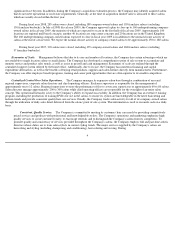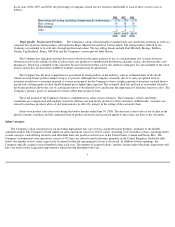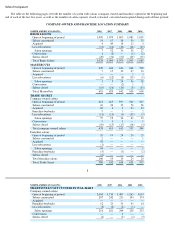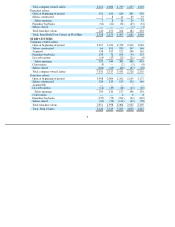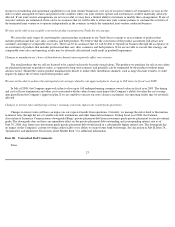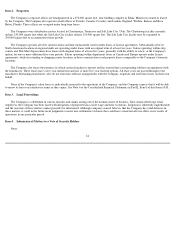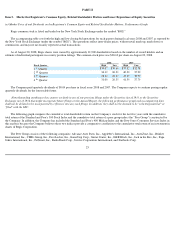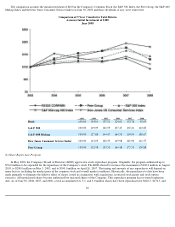Supercuts 2008 Annual Report Download - page 18
Download and view the complete annual report
Please find page 18 of the 2008 Supercuts annual report below. You can navigate through the pages in the report by either clicking on the pages listed below, or by using the keyword search tool below to find specific information within the annual report.
generally uniform, allowing the Company to place large orders for these items with cost savings due to the economies of scale.
The size of the Company's salons ranges from 500 to 5,000 square feet, with the typical salon having about 1,200 square feet. At present,
the cost to the Company of normal tenant improvements and furnishing of a new salon, including inventories, ranges from approximately
$25,000 to $225,000, depending on the size of the salon and the concept. Less than ten percent of all new salons will have costs greater than
normal with a cost between $225,000 and $500,000 to furnish. International Sassoon salons costs could be even greater than the ranges above.
Of the total leasehold costs, approximately 70 percent of the cost is for leasehold improvements and the balance is for salon fixtures, equipment
and inventories.
The Company maintains its own design and real estate department, which designs and supervises the leasehold installations, furnishing and
fixturing of all new company-owned salons and certain franchise locations. The Company has developed considerable expertise in designing
salons. The design and real estate staff focus on visual appeal, efficient use of space, cost and rapid completion times.
Salon Management Information Systems:
At all of its company-owned salons, the Company utilizes a point-of-
sale (POS) information system to collect daily sales information. Salon
employees deposit cash receipts into a local bank account on a daily basis. The POS system sends the amount expected to be deposited to the
corporate office, where the amount is reconciled daily with local deposits transferred into a centralized corporate bank account. The salon POS
information is consolidated into several management systems maintained at the corporate office. The information is also used to generate payroll
information, monitor salon performance, manage salon staffing and payroll costs, and generate customer data to identify and anticipate industry
pricing and staffing trends. The corporate information systems deliver information of product sales to improve its inventory control system,
including recommendations for each salon of monthly product replenishments.
Management believes that its information systems provide the Company with operational efficiencies as well as advantages in planning and
analysis which are generally not available to competitors. The Company continually reviews and improves its information systems to ensure
systems and processes are kept up to date and that they will meet the growing needs of the Company. A new, international version of the
POS system has been developed and is being tested in selected international salons. The goal of information systems is to maximize the overall
value to the business while improving the output per dollar spent by implementing cost-effective solutions and services.
Salon Competition:
The hair care industry is highly fragmented and competitive. In every area in which the Company has a salon, there are competitors offering
similar hair care services and products at similar prices. The Company faces competition within malls from companies which operate salons
within department stores and from smaller chains of salons, independently owned salons and, to a lesser extent, salons which, although
independently owned, are operating under franchises from a franchising company that may assist such salons in areas of training, marketing and
advertising.
Significant entry barriers exist for chains to expand nationally due to the need to establish systems and infrastructure, recruitment of
experienced hair care management and adequate store staff, and leasing of quality sites. The principal factors of competition in the affordable
hair care category are quality, consistency and convenience. The Company continually strives to improve its performance in each of these areas
and to create additional points of differentiation versus the competition. In order to obtain locations in shopping malls, the Company must be
competitive as to rentals and other customary tenant obligations.
16


